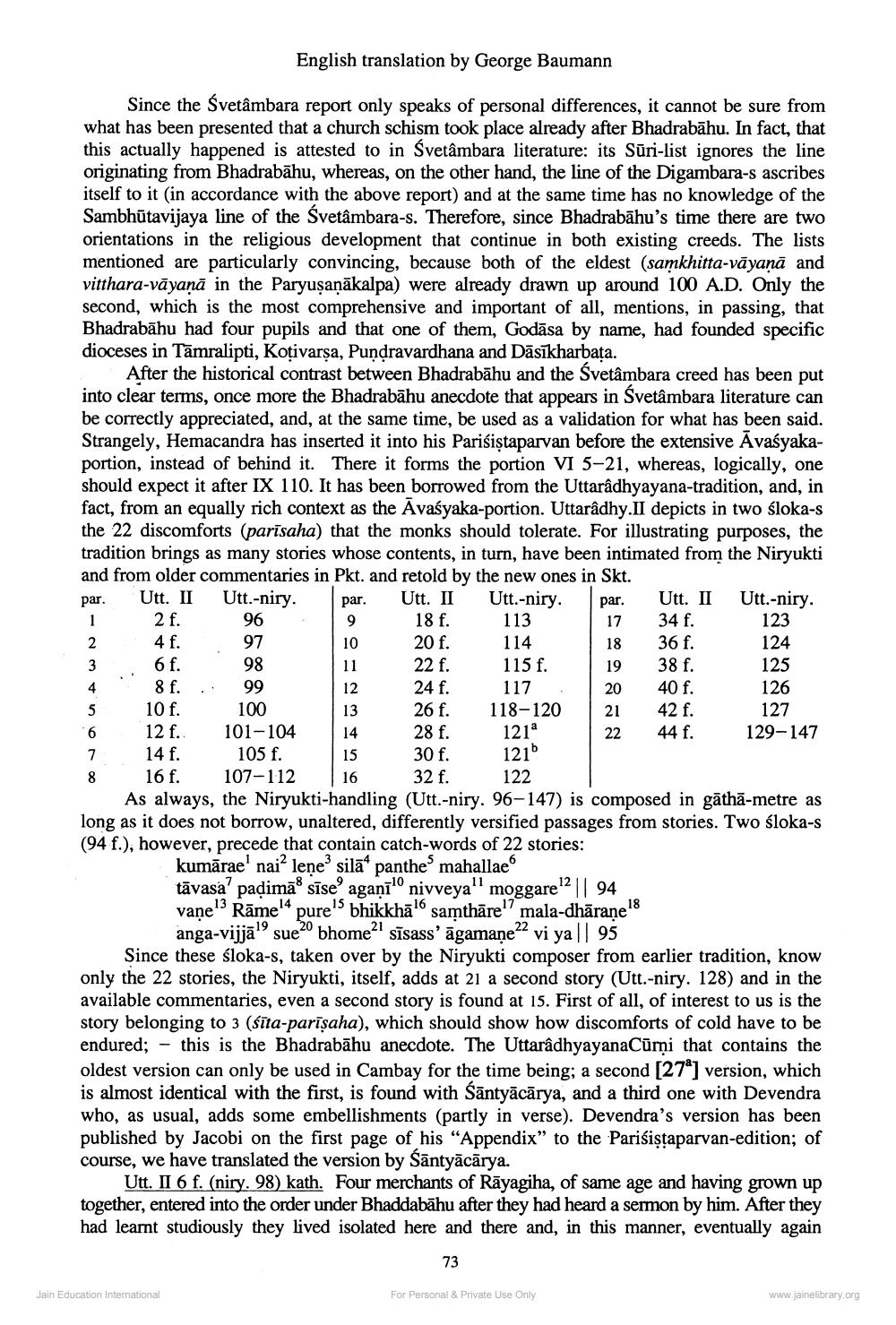________________
English translation by George Baumann
Since the Śvetâmbara report only speaks of personal differences, it cannot be sure from what has been presented that a church schism took place already after Bhadrabahu. In fact, that this actually happened is attested to in Svetâmbara literature: its Sūri-list ignores the line originating from Bhadrabahu, whereas, on the other hand, the line of the Digambara-s ascribes itself to it (in accordance with the above report) and at the same time has no knowledge of the Sambhūtavijaya line of the Svetâmbara-s. Therefore, since Bhadrabahu's time there are two orientations in the religious development that continue in both existing creeds. The lists mentioned are particularly convincing, because both of the eldest (samkhitta-vāyaṇā and vitthara-vāyaṇā in the Paryuṣaṇakalpa) were already drawn up around 100 A.D. Only the second, which is the most comprehensive and important of all, mentions, in passing, that Bhadrabahu had four pupils and that one of them, Godāsa by name, had founded specific dioceses in Tamralipti, Kotivarsa, Pundravardhana and Dāsīkharbata.
After the historical contrast between Bhadrabahu and the Svetâmbara creed has been put into clear terms, once more the Bhadrabahu anecdote that appears in Svetâmbara literature can be correctly appreciated, and, at the same time, be used as a validation for what has been said. Strangely, Hemacandra has inserted it into his Pariśistaparvan before the extensive Avaśyakaportion, instead of behind it. There it forms the portion VI 5-21, whereas, logically, one should expect it after IX 110. It has been borrowed from the Uttarâdhyayana-tradition, and, in fact, from an equally rich context as the Avasyaka-portion. Uttarâdhy.II depicts in two śloka-s the 22 discomforts (parisaha) that the monks should tolerate. For illustrating purposes, the tradition brings as many stories whose contents, in turn, have been intimated from the Niryukti and from older commentaries in Pkt. and retold by the new ones in Skt.
Utt. II Utt.-niry. par.
Utt. II
Utt.-niry.
2 f.
96
9
18 f.
113
4 f.
20 f.
114
6 f.
22 f.
115 f.
8 f.
24 f.
117
10 f.
26 f.
118-120
12 f..
28 f.
121a
14 f.
30 f.
121b
16 f.
32 f.
122
As always, the Niryukti-handling (Utt.-niry. 96-147) is composed in gāthā-metre as long as it does not borrow, unaltered, differently versified passages from stories. Two śloka-s (94 f.), however, precede that contain catch-words of 22 stories:
kumārae' nai2 lene3 sila panthe" mahallae
tāvasa padima sise aganī1 nivveya11 moggare12 || 94 vane 13 Rame14 'pure' bhikkha1 samthare" mala-dhāraṇe18 anga-vijja1 sue20 bhome21 sīsass' agamane22 vi ya|| 95
par.
1
2
3
4
5
6
7
8
97
98
99
100
101-104
105 f.
107-112
Jain Education International
10
11
12
13
14
15
16
par.
17
18
19
For Personal & Private Use Only
20
21
22
Utt. II
34 f.
36 f.
38 f.
40 f.
42 f.
44 f.
Since these śloka-s, taken over by the Niryukti composer from earlier tradition, know only the 22 stories, the Niryukti, itself, adds at 21 a second story (Utt.-niry. 128) and in the available commentaries, even a second story is found at 15. First of all, of interest to us is the story belonging to 3 (sīta-parīṣaha), which should show how discomforts of cold have to be endured; this is the Bhadrabahu anecdote. The UttarâdhyayanaCūmi that contains the oldest version can only be used in Cambay for the time being; a second [27] version, which is almost identical with the first, is found with Santyācārya, and a third one with Devendra who, as usual, adds some embellishments (partly in verse). Devendra's version has been published by Jacobi on the first page of his "Appendix" to the Parisiṣṭaparvan-edition; of course, we have translated the version by Santyācārya.
Utt. II 6 f. (niry. 98) kath. Four merchants of Rayagiha, of same age and having grown up together, entered into the order under Bhaddabahu after they had heard a sermon by him. After they had learnt studiously they lived isolated here and there and, in this manner, eventually again
73
Utt.-niry. 123
124
125
126
127
129-147
www.jainelibrary.org




